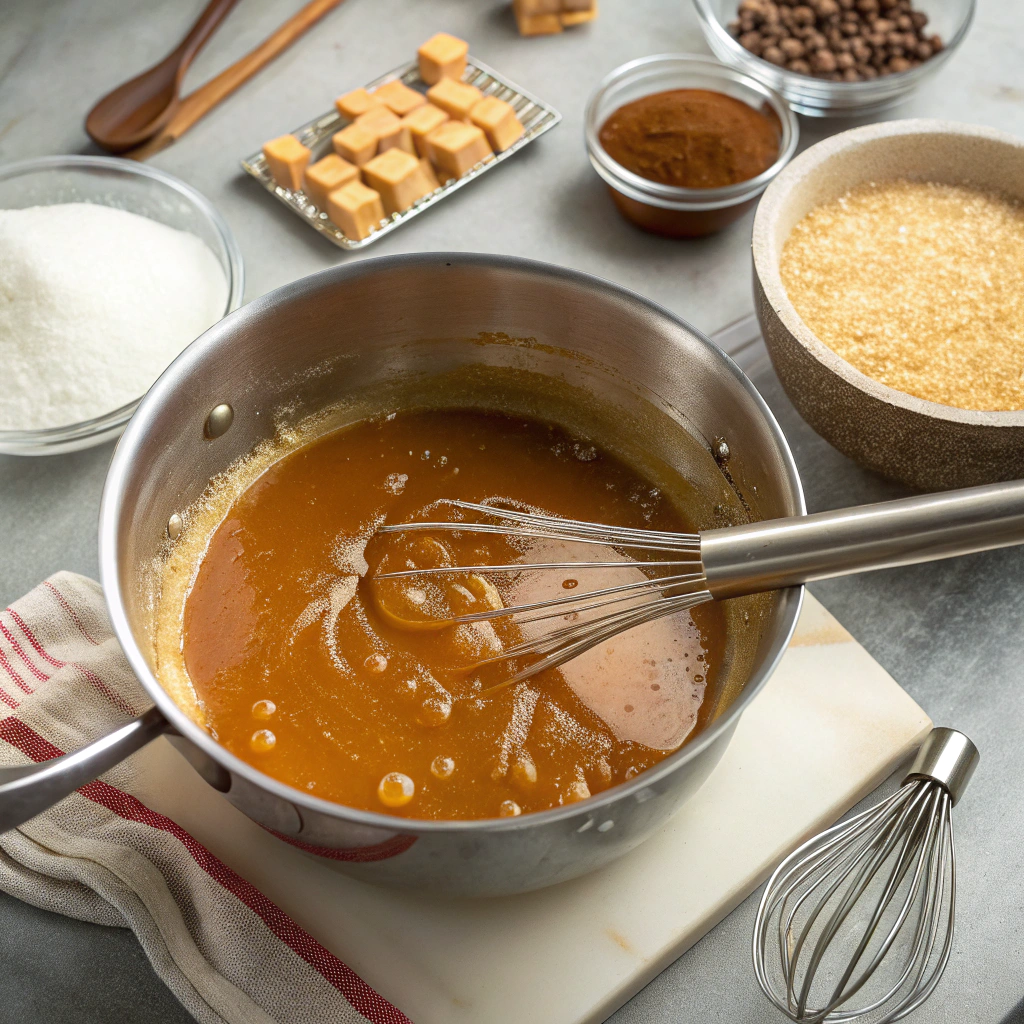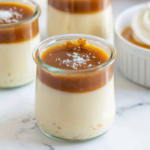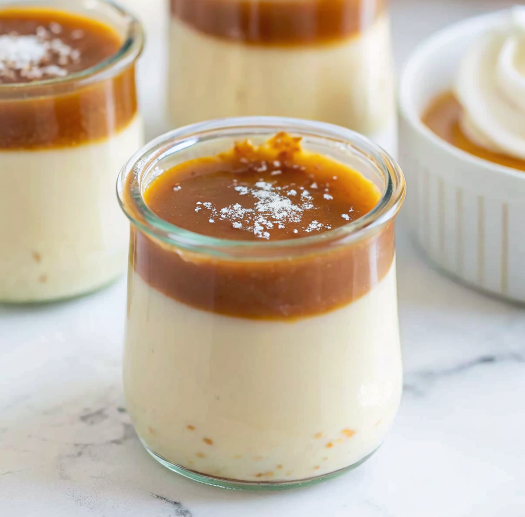Discover the secret to creating silky, restaurant-quality Italian butterscotch budino in your own kitchen with this foolproof recipe. This luxurious dessert combines the rich, caramelized sweetness of brown butter and sugar with a velvety smooth custard that melts on your tongue. Many home cooks struggle with achieving the perfect smooth texture and rich flavor that makes butterscotch budino special – from preventing curdled eggs to mastering the ideal caramel base. This comprehensive guide will teach you authentic techniques, professional troubleshooting tips, and the cultural secrets that separate true Italian Authentic Italian Desserts from ordinary puddings. Whether you’re following traditional James Beard’s Budino Technique or exploring modern variations, you’ll master flawless budino every time.
Table of Contents
What Makes Butterscotch Budino a Classic Italian Dessert: Origins and Cultural Significance
The story of butterscotch budino begins in Northern Italy, where “budino” simply means pudding, but the execution transforms humble custard into culinary poetry. Unlike American puddings that rely heavily on cornstarch or artificial thickeners, authentic Italian budino achieves its signature silky texture through careful temperature control and the perfect balance of eggs, cream, and sugar. The butterscotch variation emerged as Italian chefs embraced the deep, complex flavors of caramelized brown sugar and butter.
Traditional budino differs significantly from regular pudding in both technique and texture. While standard puddings often have a thick, spoon-coating consistency, authentic butterscotch budino maintains an almost liquid smoothness that quivers delicately when served. This ethereal texture comes from using whole eggs rather than just yolks, creating a lighter custard that showcases the butterscotch flavor without overwhelming richness.
The key characteristics that define exceptional budino include a glossy, mirror-like surface when properly set, a flavor that balances sweet caramel notes with subtle saltiness, and a texture so smooth it seems to dissolve rather than require chewing. Regional variations exist throughout Italy – some areas prefer a deeper caramel note achieved through longer cooking, while coastal regions might add a pinch of sea salt to enhance the butterscotch complexity.
In Italian culture, budino represents comfort and celebration simultaneously. Traditionally served at the end of family meals, it’s both simple enough for weeknight dinners and elegant enough for special occasions. The ritual of making budino often brings families together, with recipes passed down through generations and each family adding their own subtle variations to create their signature version.
Essential Ingredients for Authentic Butterscotch Budino: Quality and Substitutions
Creating exceptional butterscotch budino begins with selecting premium ingredients that will shine through in the final dessert. The foundation lies in choosing the right brown sugar – dark brown sugar provides deeper molasses notes and richer color, while light brown sugar offers more delicate caramel flavors. For the most authentic results, seek out turbinado or muscovado sugar, which contain natural molasses and create superior depth in your budino.
The cream and milk ratio dramatically impacts both texture and flavor intensity. Traditional recipes use a 2:1 ratio of heavy cream to whole milk, providing richness without overwhelming heaviness. The fat content helps carry the butterscotch flavor while creating that signature silky mouthfeel. For those seeking lighter alternatives, you can substitute half-and-half for heavy cream, though the final texture will be slightly less luxurious.
Fresh, room-temperature eggs are crucial for proper incorporation and smooth texture in your butterscotch budino. Use large eggs from pasture-raised hens when possible – the deeper yellow yolks contribute to both color and flavor richness. Room temperature eggs blend more easily with hot caramel, reducing the risk of curdling that can ruin your dessert.
For dietary modifications, several substitutions work well without compromising the essential character of budino. Coconut milk can replace dairy for vegan versions, though you’ll need to add a thickening agent like cornstarch. Those following egg-free diets can use aquafaba (chickpea liquid) combined with cornstarch, though the texture will differ from traditional preparations.
High-quality vanilla extract enhances the butterscotch notes without competing – seek out pure Madagascar vanilla for its creamy, floral notes that complement caramel beautifully. Sea salt plays a crucial supporting role, enhancing sweetness and adding complexity. Use fine sea salt rather than table salt for better integration and cleaner flavor.
Step-by-Step Instructions for Perfect Butterscotch Budino: Techniques and Tips
Mastering butterscotch budino requires understanding the science behind each step, starting with creating the perfect caramel base. Begin by combining 1 cup dark brown sugar with 4 tablespoons unsalted butter in a heavy-bottomed saucepan. The heavy bottom ensures even heat distribution, preventing hot spots that could burn your caramel and create bitter flavors.
Heat the sugar and butter mixture over medium-low heat, stirring constantly with a wooden spoon. This process requires patience – rushing leads to uneven caramelization and grainy texture. Watch for the mixture to bubble vigorously and deepen in color, typically 8-10 minutes. The caramel is ready when it coats the spoon and has a rich amber color with a nutty aroma that defines authentic butterscotch.

Once your caramel reaches perfection, gradually whisk in 2 cups heavy cream and 1 cup whole milk. This step requires careful attention as the mixture will bubble vigorously when the cold dairy hits the hot caramel. Learning proper Caramel Dessert Techniques helps ensure smooth incorporation without seizing. Continue whisking until the caramel completely dissolves and the mixture is smooth.
Tempering eggs safely represents the most critical technique in butterscotch budino preparation. In a separate bowl, whisk together 4 large eggs and 2 egg yolks until smooth. Slowly pour approximately one-third of the hot cream mixture into the eggs while whisking constantly. This gradual process raises the egg temperature without cooking them. Continue adding the remaining cream mixture in a steady stream while whisking vigorously.
Achieving smooth consistency requires proper straining technique. Pour the entire mixture through a fine-mesh strainer into a clean bowl, pressing any lumps through with the back of a spoon. This step removes any bits of cooked egg or undissolved sugar that could create textural imperfections in your finished budino. For restaurant-quality smoothness, strain twice through progressively finer mesh.
Professional chefs often reference techniques similar to achieving Silky Cheesecake Textures when perfecting their budino consistency. Understanding how different thickening agents work helps troubleshoot texture issues. For additional guidance on achieving perfect consistency, culinary experts recommend consulting resources like this comprehensive Cornstarch Thickening Guide when adjusting recipes for dietary needs.
Divide the strained mixture among 6-8 ramekins or serving glasses, leaving about ½ inch at the top for garnishes. Cover each portion with plastic wrap, pressing directly onto the surface to prevent skin formation. Refrigerate for at least 4 hours, though overnight chilling produces optimal texture and allows flavors to fully develop.
Troubleshooting Common Issues in Butterscotch Budino Preparation
Even experienced cooks encounter challenges when making butterscotch budino, but understanding common problems and their solutions ensures consistent success. Curdled eggs represent the most frequent issue, typically resulting from adding hot liquid too quickly or using eggs directly from refrigeration. Prevention involves bringing eggs to room temperature before use and maintaining constant whisking during the tempering process.
If curdling occurs despite precautions, immediate action can often salvage your budino. Remove the mixture from heat and strain immediately through a fine mesh, pressing solids through with a spoon. For severe curdling, blend the mixture with an immersion blender for 30-60 seconds, which often restores smoothness. Professional techniques from Epicurious Budino Essentials provide additional recovery methods for challenging situations.
Lumpy texture in finished butterscotch budino usually stems from insufficient straining or incomplete caramel dissolution. Double-straining prevents most texture issues, but if lumps appear after chilling, gentle reheating while whisking can help. Avoid boiling, which will scramble the eggs, instead using low heat and patience to restore smoothness.
Sweetness imbalances require careful adjustment during preparation rather than after completion. Overly sweet budino benefits from a pinch of sea salt or a few drops of lemon juice to balance flavors. Under-sweetened budino is more challenging to fix after cooking, though serving with sweetened whipped cream or caramel sauce can compensate.
Temperature and timing control prevent most issues before they occur. Use a candy thermometer to monitor caramel temperature – optimal range sits between 340-350°F (170-175°C) for deep flavor without bitterness. Cooking times vary based on your specific equipment, so focus on visual and aromatic cues rather than strict timing for best results with your butterscotch budino.
Serving and Storage Tips for Butterscotch Budino: Presentation and Make-Ahead Strategies
Proper chilling time ensures your butterscotch budino reaches its optimal texture and flavor development. While minimum chilling requires 4 hours, professional chefs recommend overnight refrigeration for superior results. The extended time allows flavors to marry completely and achieves the signature silky consistency that distinguishes authentic budino from ordinary puddings.
Presentation elevates budino from simple dessert to restaurant-worthy finale. Serve in clear glass ramekins or elegant stemware to showcase the beautiful golden color. Classic garnishes include lightly sweetened whipped cream, a drizzle of salted caramel sauce, or delicate butter cookies. For sophisticated presentations, consider garnishing with toasted nuts, a sprinkle of flaky sea salt, or fresh fruit that complements the butterscotch flavors.
Make-ahead strategies make butterscotch budino perfect for entertaining. The dessert maintains peak quality for up to three days when properly stored, making it ideal for dinner parties and special occasions. Prepare garnishes separately and add just before serving to maintain optimal textures and visual appeal.
Storage methods significantly impact longevity and quality. Cover each serving with plastic wrap pressed directly onto the surface to prevent skin formation. For longer storage, budino can be frozen for up to one month, though texture changes slightly upon thawing. Thaw frozen budino gradually in the refrigerator for 24 hours before serving for best results.
Creative Variations and Flavor Twists on Classic Butterscotch Budino
Exploring variations allows you to personalize your butterscotch budino while maintaining its authentic character. Salted caramel versions add sophisticated complexity by incorporating sea salt during the caramel-making process. Use 1-2 teaspoons of flaky sea salt with the brown sugar, adjusting to taste preference. This variation complements the sweetness while adding depth that appeals to modern palates.
Dairy-free alternatives make budino accessible to those with dietary restrictions without sacrificing flavor. Replace heavy cream with full-fat coconut milk and substitute dairy milk with unsweetened almond or oat milk. Add 1 tablespoon cornstarch dissolved in cold plant milk to achieve proper thickening, as plant-based alternatives don’t set as firmly as traditional dairy versions.
Seasonal flavor additions transform basic butterscotch budino into holiday specialties. Autumn versions benefit from warming spices like cinnamon, nutmeg, or cardamom added during the caramel stage. Winter variations might include vanilla bean paste or rum extract (for those who consume alcohol) for festive appeal. Spring and summer adaptations could incorporate citrus zest or fresh herbs like basil for unexpected sophistication.
Individual versus family-style serving options offer flexibility for different occasions. Traditional individual ramekins provide elegant portion control and professional presentation. Family-style preparation in a large glass bowl creates casual, sharing-friendly desserts perfect for relaxed gatherings. Consider using vintage glassware or modern serving vessels that complement your dining style and occasion.
Creative flavor combinations expand the possibilities while respecting the essential butterscotch character. Coffee versions add espresso powder during caramel preparation for sophisticated mocha notes. Fruit variations incorporate pureed seasonal fruits like pears or apples, which naturally complement butterscotch flavors. Always maintain the core technique while adjusting flavoring elements to preserve the signature smooth texture that defines exceptional budino.
Frequently Asked Questions
How long does it take for butterscotch budino to set completely and achieve the perfect texture?
Butterscotch budino requires a minimum of 3-4 hours of refrigeration to set completely, though overnight chilling (8-12 hours) produces optimal texture and flavor development. The custard should feel firm to gentle touch and have a glossy surface when properly set. Proper setting ensures the characteristic silky, spoon-able consistency that doesn’t feel liquid or overly thick. Temperature consistency in your refrigerator affects setting time – avoid frequent door opening during the initial chilling period for best results.
Can I make butterscotch budino without heavy cream, and what are the best substitutes?
Yes, you can successfully make butterscotch budino using cream alternatives, though texture will vary slightly. Half-and-half provides the closest substitute, maintaining richness while reducing fat content. For dairy-free versions, full-fat coconut milk works excellently, creating creamy texture with subtle coconut undertones that complement butterscotch. When using plant-based alternatives like oat cream or cashew cream, add 1-2 tablespoons of cornstarch to ensure proper thickening and set.
What distinguishes authentic Italian budino from regular butterscotch pudding?
Authentic Italian butterscotch budino differs significantly from American puddings in technique, texture, and ingredient ratios. Traditional budino uses whole eggs rather than just yolks, creating lighter consistency while maintaining richness. Italian preparation emphasizes slow caramel development and gentle cooking temperatures, resulting in silkier texture without artificial thickeners. The final consistency should be pourable when warm but set to a delicate, quivering texture when chilled – much lighter than typical American puddings that rely heavily on cornstarch or artificial stabilizers.
How do I prevent my butterscotch budino from curdling during cooking?
Preventing curdling in butterscotch budino requires proper tempering technique and temperature control. Always bring eggs to room temperature before beginning, use medium-low heat throughout the process, and add hot liquid to eggs gradually while whisking constantly. The key lies in slowly raising egg temperature without shocking them with sudden heat. If mixture begins to curdle, immediately remove from heat and strain through fine mesh while still warm. Maintaining consistent whisking motion and avoiding temperature extremes prevents most curdling issues.
Is it possible to prepare butterscotch budino ahead of time for entertaining, and how?
Butterscotch budino excels as a make-ahead dessert, maintaining quality for up to three days when properly stored. Prepare the complete dessert 1-2 days before serving, covering each portion with plastic wrap pressed directly onto the surface. Store garnishes separately and add just before serving to maintain optimal textures. For larger gatherings, budino can be multiplied easily – just ensure adequate refrigerator space for proper chilling. The flavors actually improve with time, making advance preparation beneficial rather than compromising.
What’s the best way to fix butterscotch budino that turned out too sweet or not sweet enough?
Adjusting sweetness in completed butterscotch budino requires creative serving solutions since the dessert cannot be easily modified once set. For overly sweet budino, serve with unsweetened whipped cream, a pinch of flaky sea salt, or tart fruit garnishes like fresh berries. Under-sweetened budino benefits from drizzled honey, caramel sauce, or sweet garnishes. For future batches, taste the mixture before final straining and adjust with small amounts of sugar dissolved in warm cream, or balance excessive sweetness with a few drops of lemon juice or additional sea salt during preparation.

Mastering butterscotch budino transforms your dessert repertoire with a sophisticated Italian classic that impresses guests while remaining surprisingly approachable for home cooks. The techniques you’ve learned – from creating perfect caramel to achieving silky smooth texture – ensure restaurant-quality results every time you prepare this luxurious dessert. This versatile recipe adapts beautifully to dietary needs and seasonal variations while maintaining its essential character that has delighted Italian families for generations.
The make-ahead convenience makes butterscotch budino ideal for entertaining, allowing you to focus on your guests while serving an elegant finale that demonstrates your culinary skills. Whether you choose the classic preparation or explore creative variations, each spoonful delivers the perfect balance of rich butterscotch flavor and ethereal texture that defines exceptional budino. Embrace this timeless recipe with confidence, knowing that your homemade butterscotch budino will create lasting memories around your dining table.
Print
Ultimate Guide to Making Authentic Butterscotch Budino: Tips, Variations, and Secrets
- Total Time: 3 hours 55 minutes
- Yield: 4 servings 1x
- Diet: Vegetarian
Description
Indulge in pure luxury with this absolutely divine Butterscotch Budino that brings the elegance of Italian dessert tradition to your table! This silky, sophisticated pudding features a rich dark caramel base with deep butterscotch flavors that melt on your tongue like velvet. The secret is in the slow caramelization of brown sugar and the careful tempering technique that creates that perfect, lump-free custard texture. With just a hint of rum for complexity, this restaurant-quality dessert is surprisingly achievable at home. Perfect for dinner parties, romantic evenings, or anytime you want to treat yourself to something truly special!
Ingredients
- ½ cup packed dark brown sugar
- ¼ teaspoon kosher salt
- ¼ cup water
- 2 tablespoons unsalted butter
- 1½ cups heavy cream
- ¾ cup whole milk
- 1 large egg
- 2 large egg yolks
- 2 tablespoons cornstarch
- 1 teaspoon cornstarch
- 1 tablespoon white rum
For Serving (Optional):
- Whipped cream
- Caramel sauce drizzle
- Toasted nuts or sea salt flakes
Instructions
- Create the Caramel Magic: In a deep, heavy-bottomed saucepan, combine brown sugar, salt, and water over medium-high heat. Bring to a rolling boil and cook 7-10 minutes until the caramel turns very dark and bubbles vigorously—this deep caramelization creates that incredible butterscotch depth!
- Build the Luxurious Base: Immediately turn off heat and carefully whisk in butter (it will bubble dramatically!). Slowly pour in heavy cream while whisking continuously—be cautious as the mixture will bubble up. Return to medium-low heat and stir until all sugar dissolves, then whisk in milk.
- Master the Tempering Technique: In a separate bowl, whisk together the whole egg, egg yolks, and both measurements of cornstarch until smooth. Slowly drizzle 1 cup of the hot cream mixture into the eggs while whisking constantly—this prevents scrambling and creates silky perfection!
- Cook to Custard Perfection: Pour the tempered egg mixture back into the saucepan and increase heat to medium-high. Bring to a gentle simmer, whisking constantly, and cook about 2 minutes until beautifully thickened and coating the back of a spoon.
- Strain for Silky Smoothness: Remove from heat and immediately pour through a fine-mesh strainer into a clean bowl, pressing any lumps through with a spoon. Whisk in the rum for that sophisticated flavor complexity.
- Chill to Perfection: Divide among 4 serving glasses and let cool to room temperature (about 20 minutes). Cover with plastic wrap, pressing directly onto the surface to prevent a skin from forming, then refrigerate 3-4 hours until thoroughly chilled and set.
- Serve with Style: Present your elegant budino chilled, optionally topped with a dollop of whipped cream, caramel drizzle, or a sprinkle of toasted nuts or sea salt flakes for that restaurant-quality finish!
Notes
The secret to perfect budino is patience during the caramelization—let that brown sugar get really dark for maximum butterscotch flavor! The tempering step is crucial for achieving that silky, lump-free texture, so add the hot cream slowly to the eggs. A fine-mesh strainer ensures perfect smoothness. The rum adds sophistication but can be omitted if preferred. This dessert actually improves with time, so it’s perfect for making ahead. Store covered in the refrigerator for up to 3 days. Serve in beautiful glasses to showcase that gorgeous golden color!
- Prep Time: 15 minutes
- Cook Time: 20 minutes
- Category: Dessert
- Method: Custard Making
- Cuisine: Italian
Nutrition
- Serving Size: 1 serving (1/4 of recipe)
- Calories: 385
- Sugar: 32g
- Sodium: 180mg
- Fat: 26g
- Saturated Fat: 16g
- Unsaturated Fat: 10g
- Trans Fat: 0g
- Carbohydrates: 35g
- Fiber: 0g
- Protein: 5g
- Cholesterol: 185mg
Keywords: butterscotch budino, italian pudding, caramel custard, elegant dessert, make-ahead dessert

